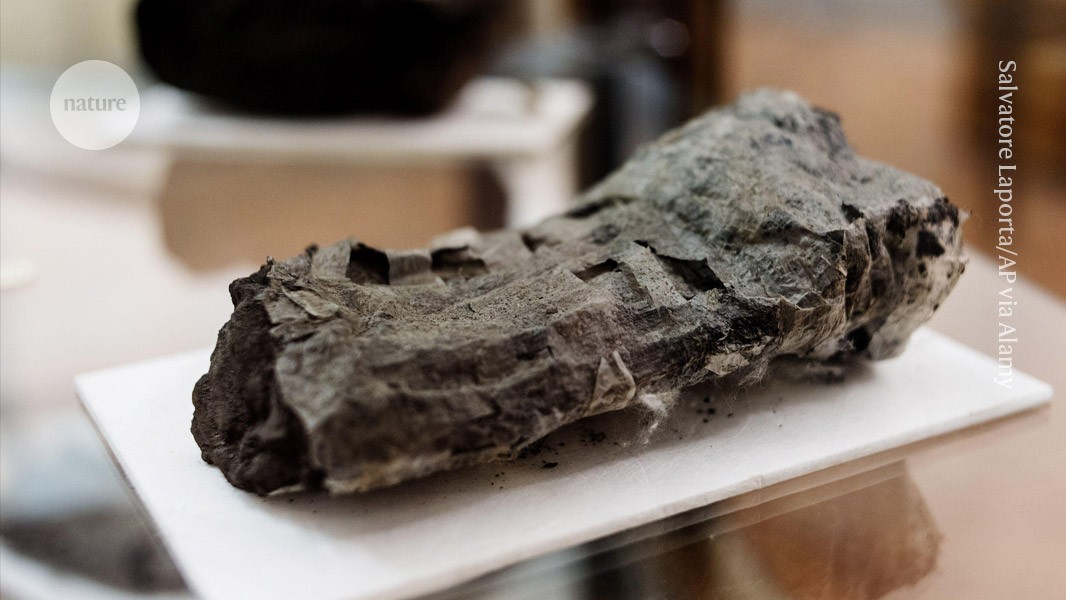The text of dozens of burnt Herculaneum scrolls could soon be revealed

Scans of 18 ancient papyri that were buried by the eruption of Mount Vesuvius look ‘very promising’, and there are plans to digitally unroll many more

A Herculaneum scroll, burnt and encased in volcanic material, on display at the National Library in Naples.Credit: Salvatore Laporta/AP via Alamy
On 27 March, a private jet arrived at London Luton Airport with some unusual, delicate cargo. Rather than designer luggage, the plane carried 18 ancient scrolls from the Vittorio Emanuele III National Library in Naples, Italy. The tightly rolled papyri were being transported to the Diamond Light Source particle accelerator near Oxford, where researchers used the synchrotron’s powerful X-rays to reveal the scrolls’ contents.
The mission is part of a huge scaling up of efforts to decipher the ‘Herculaneum scrolls’, burnt and buried in the eruption of Mount Vesuvius in 79 AD, after text inside one of them was successfully deciphered using artificial intelligence (AI) last year. “It’s like a dream” to have reached this point, says Brent Seales, a computer scientist at the University of Kentucky in Lexington, who has been working to read the scrolls for 20 years. “It seems so impossible and yet we’re doing it.”
A first look at the newest scans reveals that at least five of the scrolls show what look like clear signs of visible ink, researchers tell Nature. That’s “very promising”, says Stephen Parsons, a computer scientist at the University of Kentucky who is also involved with efforts to read the scrolls. It means that the scrolls could be easier to read than previously thought, he adds. Meanwhile, a papyrus at the Bodleian Libraries at the University of Oxford, scanned last year, is yielding unprecedented amounts of data, and dozens more scrolls are due to be scanned in France next month.
Buried treasure
More than 1,800 carbonized papyri were discovered in the eighteenth century among the remains of a luxurious Roman villa at Herculaneum, near Naples. Although many were torn to pieces by various efforts to open them, several hundred intact scrolls remain. They offer an unprecedented cache of ancient knowledge, potentially containing completely unknown texts direct from the pens of their Greek and Roman authors. “Everything we find is a surprise,” says Federica Nicolardi, a papyrologist at the University of Naples Federico II, who accompanied the most recently scanned scrolls on their journey from Italy to Diamond.

A scroll in its 3D-printed protective case is prepared for scanning at the Diamond Light Source particle accelerator.Credit: Emil Bendixen for Nature
The trip was part of the Vesuvius Challenge, a competition that Seales set up in 2023 with Silicon Valley entrepreneur Nat Friedman, to encourage efforts to decipher computed tomography (CT) scans of the unopened Herculaneum scrolls. In February last year, the challenge awarded US$700,000 to a team of students who developed an AI tool that revealed the first paragraphs of a scroll — a Greek philosophical text about music and pleasure, possibly written by the philosopher Philodemus.
The focus of the Vesuvius Challenge is now to optimize and automate the techniques, says Seales, and ultimately to scan and read all of the surviving scrolls.
Scaling up
Until now, only five of the scrolls had been imaged at high resolution, so an important first step was to gather more scans. Nicolardi selected the 18 papyri for this phase, prioritizing intact scrolls that might contain complete texts, as well as scrolls with a range of shapes — some are flattened, others compressed along their length like a spring — to test how the machine-learning algorithms cope with different patterns of distortion.
Diamond is one of the few facilities that can produce X-rays to scan these scrolls at sufficiently high resolution. But transporting each fragile piece is challenging. “It’s like papier mâché made out of glass,” says Seales. “If you dropped it, it would probably shatter.” Researchers in Naples modelled the external shapes of the scrolls using photogrammetry, then 3D-printed customized travel cases to snugly fit each one.
The scrolls were scanned inside their protective cases in late March, using an X-ray beam of 53 keV to give a resolution of 8 micrometres. In a control room nearby, the cross-section of the papyrus showed up on the computer screen as a complex spiral, thin as silk, glowing white against a dark background.

A freshly scanned scroll, seen from the control room. The cross section on the right hand side of the screen reveals a complex spiral of rolled-up papyrus. Credit: Emil Bendixen for Nature
Each scroll is scanned in dozens of chunks, and the data are recombined into a single data set. The next step is mapping the surface of the wound-up papyrus across all the CT slices so it can be virtually unrolled into a flat image. Initially, this was done painstakingly by hand, taking months, so a major focus of the Vesuvius Challenge is to automate this process. That has proven difficult, especially where different layers of a scroll are squashed tightly together. An innovation within the past few months has been to use imaging tools, originally developed to trace the connections between neurons, to map the horizontal and vertical fibres in the papyrus. “We’re getting really good at finding the fibres,” says Friedman. “From there, it’s much easier to find the surfaces.” By combining this technique with other improvements, “we’re seeing better and better results every week”.
Invisible ink
Enjoying our latest content?
Login or create an account to continue
- Access the most recent journalism from Nature's award-winning team
- Explore the latest features & opinion covering groundbreaking research
or
Sign in or create an accountdoi: https://doi.org/10.1038/d41586-025-01087-y
This story originally appeared on: Nature - Author:Jo Marchant


















